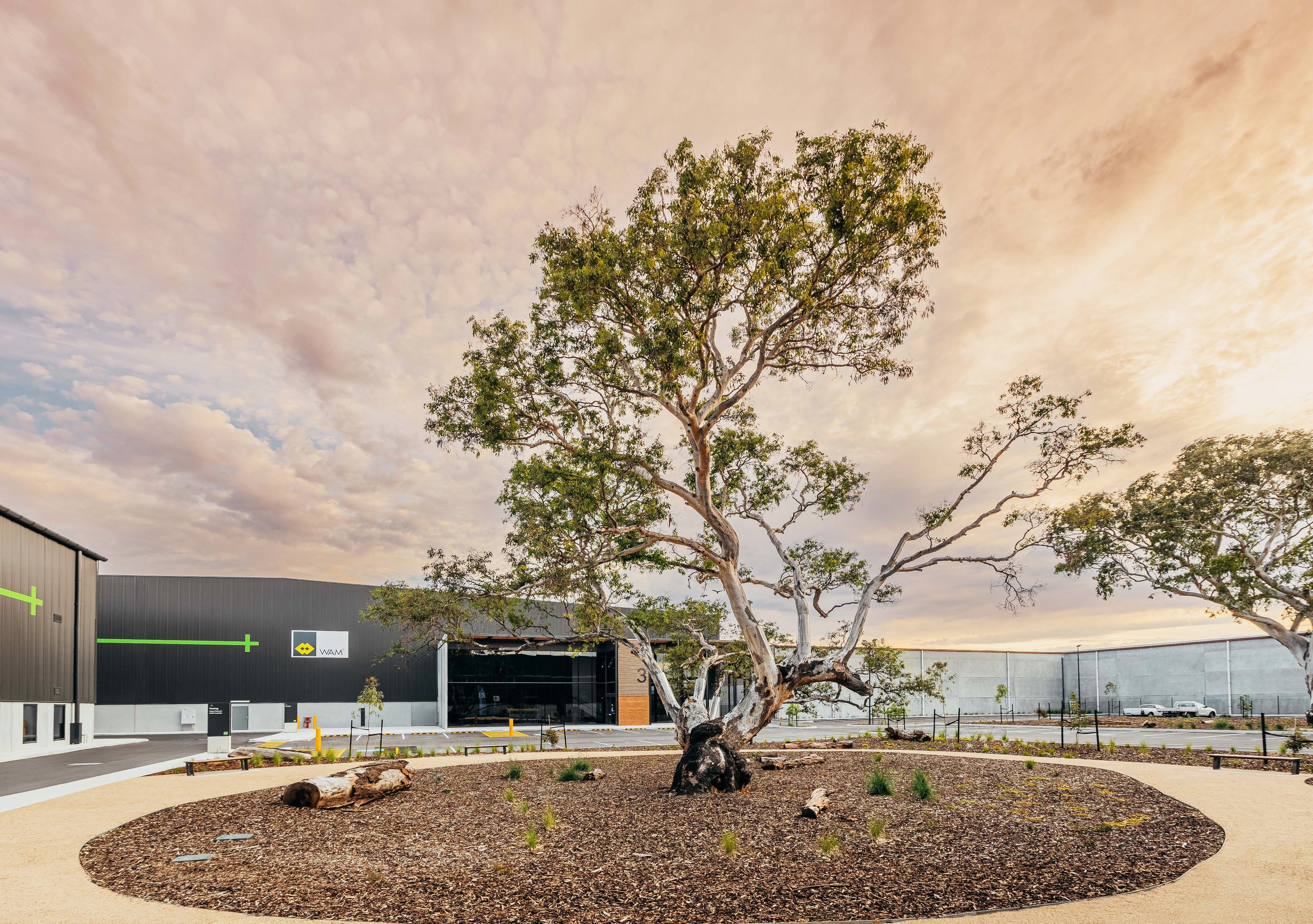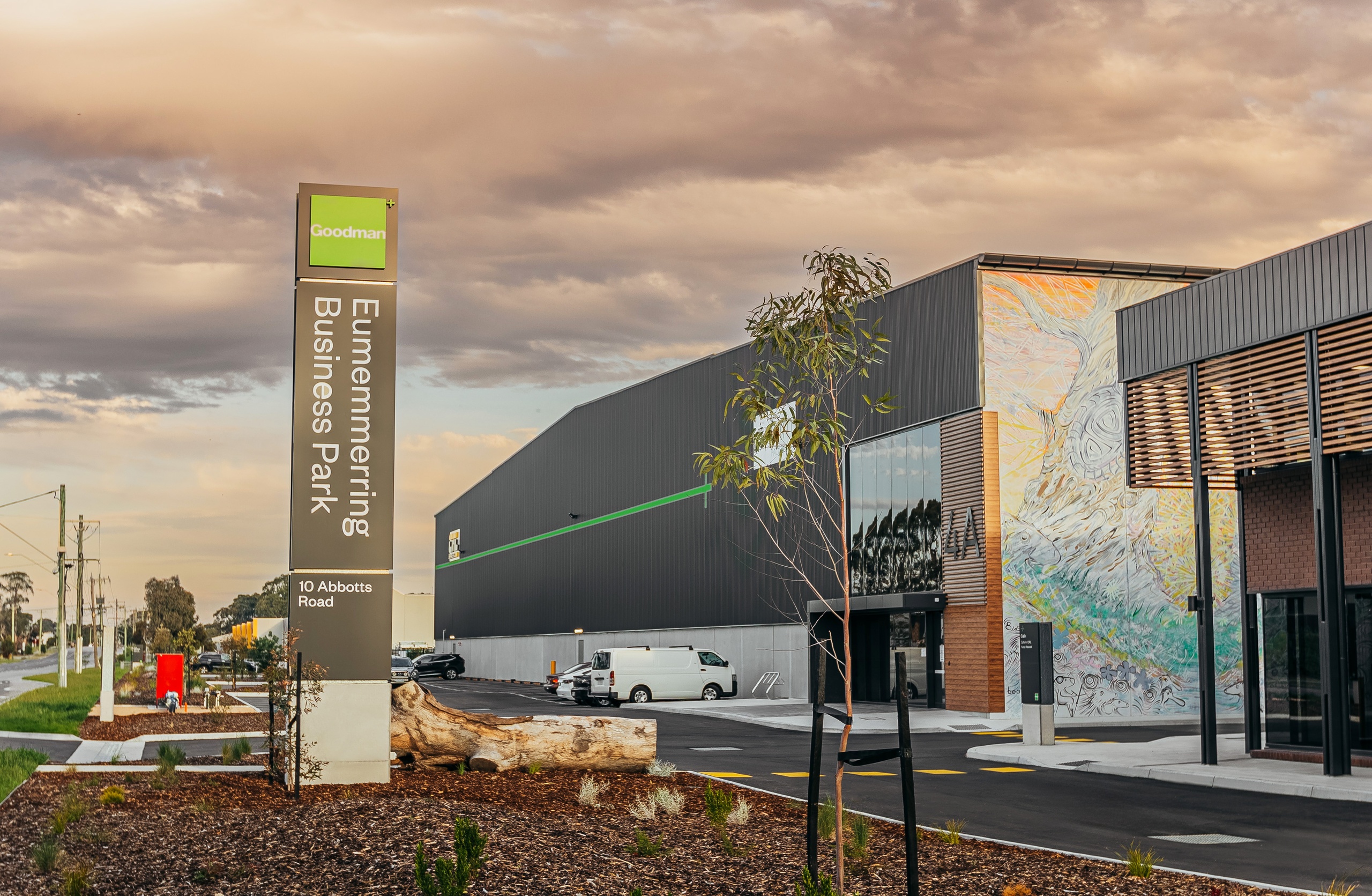Eumemmerring Business Park in Dandenong South, Victoria, is the first industrial, and the second ever project to achieve a Green Star Buildings certification, with a 5 Star Green Star rating representing Australian excellence.
When Goodman acquired the former electrical parts site in 2019, they saw an opportunity to turn this 1970s industrial relic into a beacon of modern sustainability. With a vision rooted in circular design, Goodman set out to revitalise the ageing site into Eumemmerring Business Park – a cutting-edge, resilient business precinct.
Key to this transformation was the decision to retain and repurpose two existing office pods, integrating them into a new state-of-the-art office building, connected to warehouse operations via an aerobridge. This approach not only preserved finite materials, and minimised waste, but it also significantly reduced upfront embodied carbon – a key factor in sustainable construction.
Goodman’s efforts paid off with Eumemmerring Business Park becoming the first industrial building to achieve certification under the Green Star Buildings rating tool — setting a new standard for sustainability in the industrial sector. This project exemplifies how thoughtful design and a commitment to circularity can breathe new life into old structures, creating sustainable, future-ready business environments.
Emma McMahon, General Manager of Sustainability – Australia, at Goodman said it was important to be recognised for ongoing sustainability commitments.
“At Goodman, sustainability is integrated throughout our business. Being one of the first organisations to be awarded this rating recognises the commitment made by the business to reduce our environmental impact and support the long-term viability of the communities we operate in.”
This achievement has been eagerly anticipated by the Green Building Council of Australia, a certification which was acknowledged by Davina Rooney, GBCA CEO.
“Eumemmerring Business Park is a shining example of what’s possible when industry leaders like said Goodman prioritise sustainability.
“As the first industrial project to be certified under Green Star Buildings, it’s not just meeting expectations, it’s redefining them.”
In line with refurbishment and preservation, the masterplan of the estate also included protecting the living ecosystem of the Red Gum in the area. This meant safeguarding ten significant native Eucalyptus trees on the site that are well over 100 years old.

Eumemmerring fast facts
- 999kW solar system
- 14 EV chargers
- 40kL rainwater tanks
- Smart irrigation
- Low water use plants, including selection of native plants
- Achieved a 15.81% reduction in upfront carbon and 30.81% reduction in whole of life carbon
- All electric (no gas)
- 99.6% diversion of construction waste from landfill
Positive, responsible, healthy
Eumemmerring Business Park goes above and beyond what we expect to see from industrial projects. Designed to be highly energy efficient and all-electric, a 999kw solar array system and extensive electric vehicle charging stations have been installed, with space for a further 34 to be accommodated in the future as the accessibility of electric vehicles grows.
The choice to repurpose the existing structure and brick façade of two buildings led to a reduction in embodied carbon, and a 15.81% reduction of upfront embodied carbon was achieved through the use of supplementary cementitious materials and recycled content in the hardstand, office slab and asphalt.
The project team also focused on the health and wellbeing of staff and customers across the site, with improved natural lighting, increased fresh airflow, acoustic comfort considerations, numerous outdoor spaces to enjoy, and end of trip facilities.
Not only is it a proud moment for the project team, the response to the revitalisation of the industrial site has been positive from staff and customers alike.
“Our customers appreciate properties that are sustainable and adaptable to support their operations and sustainability targets. For Goodman people, sustainability is embedded in our values, and our key performance indicators.
Our people are determined to deliver tangible outcomes that will have a measurable and meaningful impact on the business and the wider community,” said Ms McMahon.

Why Green Star?
For the team at Goodman, a Green Star rating offers a well-recognised third-party verification, an important signal of commitment that customers, investors and industry want to see.
“Green Star provides a framework for best practice approach to environmentally sustainable design (ESD) in the built environment in Australia.
“Third-party green building certification such as Green Star is a signal to the market and stakeholders of a genuine commitment to ESG. A Green Star certification provides a method of quantifying the impact of existing and new sustainability measures that we’ve implemented. It also provides inspiration for other ESG measures the business can take in the future,” said Ms McMahon.
Green Star Buildings includes the Climate Positive Pathway - a clear set of targets aligned with the IPCC recommendations to help you deliver on a building that is built with lower emissions, fossil fuel free, powered by renewables, highly efficient, and offset with nature.
Emma McMahon’s parting words of advice for others pursuing Green Star Buildings was simple — engage early.
“It’s important that everyone involved in the project is engaged with sustainability and Green Star early on, as well as regularly throughout a project. During the development process for Eumemmerring, the project team – internally and externally – were enthusiastic and collaborated well, which contributed to the project’s success.”
Goodman has since sold Eumemmerring Business Park, but their legacy of sustainable development continues to inspire.
“We’re immensely proud to have developed the first industrial precinct to achieve Green Star Buildings certification.” said Ms McMahon.
“The Green Star Buildings tool provided a clear and effective framework for us to deliver a facility that not only meets, but exceeds, Australian sustainability standards.”